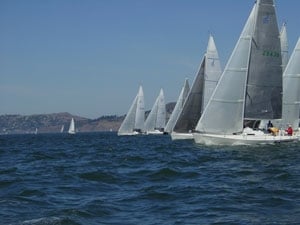
John Burnham trimmed headsails for Dave Irish on a J/105 at the International Masters Regatta on San Francisco Bay recently. If you missed the first or second installment of what he learned in the process click here.
Everybody makes mistakes in regattas, but learning to seize the opportunities you have can make up for a number of lesser miscues. As part of Dave Irish’s J/105 team, I helped make a couple of early mistakes on Day Two of the Masters Regatta, but fortunately we overcame them with a good moves later.
We sailed the first race at the end of the flood tide, so the best course was up the City Front on starboard tack where the ebb tide had already begun. Mistake No. 1 came after a good start when I saw a ribbon of current sweeping offshore past the breakwater east of the yacht club and didn’t suggest a tack. As a result we sailed out of the best current and immediately lost several places.
Mistake No. 2 almost arrived at the weather mark. St. Francis YC signals courses with starboard mark roundings in a flood tide because the fleet wants to go up the left side of the beats and down the right side of the runs. Of course they don’t take into consideration the fact that most race-boat equipment is arranged with port roundings in mind. As we got ready to round the first mark I realized that my cabin-top spin sheet winch was being used by Linda for the spinnaker halyard. I looked to the leeward side cabintop winch and realized I couldn’t use that either, because it still had the jib halyard on it. So I improvised and loaded the sheet on the primary until the others could help me sort things out. Bullet dodged.
However, as the chute filled after our mid-fleet rounding, I mustve been a bit discombobulated because I made the brilliant suggestion that we jibe. Bill said, “OK,” and Dave jibed the boat, after which I immediately realized we were heading away from the best of the remaining flood. I turned and asked, “Why did we do that?”
Now we were really struggling and to compound matters, in the lighter airs of this race, we couldnt always sail as deep an angle as we wanted with the spinnaker wed drawn. It would start to collapse along the luff as it became too depowered, so we fussed with the sail, tightening the halyard and tack line more.
Seizing the Moment No. 1: After letting most of the boats pass us as they sailed toward the right hand leeward gate mark, we crossed all of their transoms and went to the lefthand gate mark to avoid traffic. To our delight, as the breeze subsided, eight or nine of them parked in the ebb tide near the mark. We popped around our mark and suddenly found ourselves in fourth place.
Seizing the Moment No. 2: The easiest way to lose distance on these beat was to overstand the weather mark as the ebb tide began flowing stronger and stronger upwind. As the ebb built for our the second beat, we tacked to leeward and ahead of the second and third-place boats, and surprised ourselves by laying the mark and passing one of them.
Seizing the Moment No. 3: Remarkably, the boat in front of us jibed right away, just as we had at the previous weather mark. We put the pedal to the medal and sailed all the way out into the Bay on port jibe into the lesser current, then came in neck and neck with regatta organizer Don Trask to the leeward mark. We held our overlap and stayed ahead of him on the final beat to finish second behind Keith Musto, the British Olympic medalist better known in this country for making great foul weather gear and racing a Melges 24 at Key West.
Mistake No. 3 came shortly after the start of the second race. Since the ebb had now fully kicked in, we knew it would pay to tack right after the start, but we fell victim to the old problem of getting a little too good a start. We had great speed but couldn’t shed two boats on our weather side. By the time we tacked, those who had started late and tacked right immediately, such as Bruce Kirby, were launched into the lead.
Mistakes No. 4 & 5: We followed the leaders down the City Front to get current relief, and moved up to fourth place, but forgot to jibe out early enough to set up for the lefthand side of the gate, from where we’d again be sent quickly out into the strongest ebb tide. Our right side rounding and a quick tack didn’t hurt us too much, but regatta leader (John Jennings) had jumped to a 100-yard lead. We rounded the top mark in about fourth, this time with a big twist in the chute on our set, which cost us one place. Still, that wasn’t the real mistake. The real mistake was back on the City Front where we repeated Mistake No. 4 by taking a costly extra jibe along the shore and locked ourselves out of the left hand gate again. This time, with the fleet pressing in behind, it cost us much more, and we dropped to eighth on the beat, just passing one boat at the finish for a seventh.
Todays lesson was that as our crewwork–and everybody elses–improves, and with the wind slightly lighter on a crowded racecourse, strategy and tactics become paramount.
Burnhams series will conclude at sailingworld.com next week “Remembering Yesterdays Lesson–the Masters Dilemma”









